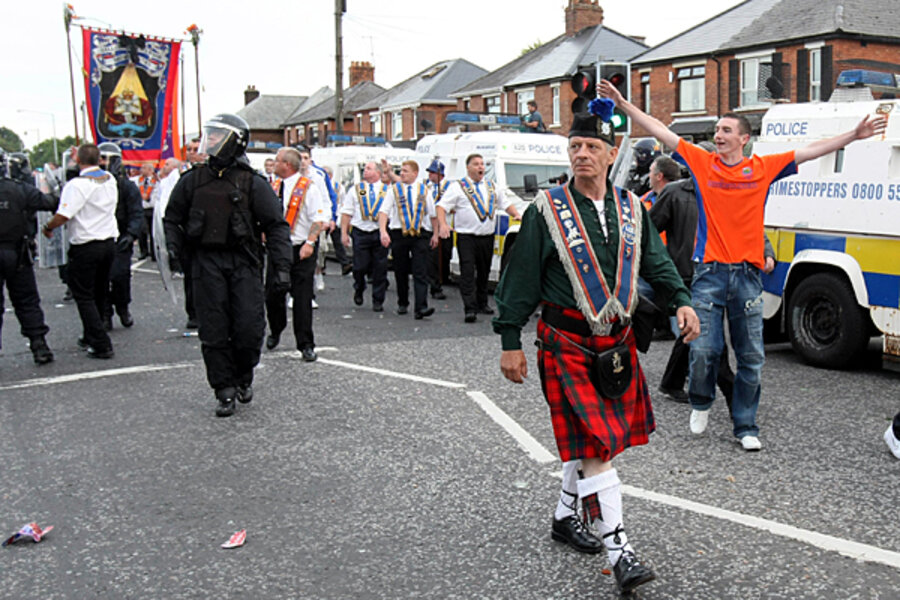Northern Ireland riots raise worries about 'bad old days'
Loading...
| Dublin, Ireland
Four consecutive nights of rioting in Belfast have left many asking why Northern Ireland’s "bad old days" have returned.
The Northern Ireland peace process has always been a roller coaster ride, even if it is one whose peaks and troughs can crest and fall at a slow pace.
But the month of July is often simultaneously tedious and terrifying as it represents the height of the so-called marching season, a roughly six-month period in which the ultraconservative and pro-British Protestant fraternal organization, the Orange Order, takes to the streets to celebrate the ascension of William of Orange to the British throne in 1690. The marchers enter areas where the local residents are Irish republicans who don’t want them there.
In past years, contentious marches through areas such as Belfast’s Ormeau Road and the Garvaghy Road in Portadown made headlines around the world as angry standoffs between Orangemen and residents descended into violence, even death. But the past decade has seen a gradual lessening of tension, and while residents and marchers are no closer to seeing eye to eye, violence has been waning – until now.
On July 11, violence erupted in Belfast when a march was forced through the republican Ardoyne area of north Belfast. Gasoline bombs, paint bombs, and bricks and other projectiles were thrown at police. Three police officers were injured when a masked man opened fire with a shotgun.
This year was the first in which Belfast took over control of local policing and justice from London. At least 27 police officers have been injured so far, and one endured injuries described as “serious” after being struck with a concrete block.
Confrontations with police have continued each night since, and on Wednesday an improvised coffee-can bomb was found.
Violence has also occurred outside Belfast. On Monday, the main Dublin-to-Belfast train line was closed following attacks on the train in the County Armagh town of Lurgan. Youths hurled gasoline bombs and attempted to hijack the train, terrifying passengers.
Condemnations from all sides
Politicians from all sides have condemned the disturbances, including the governing partners, the Democratic Unionist Party (DUP) and Sinn Féin. Some Unionists have complained that police have not responded strongly enough, but this is rejected by the policing board. Police have stated arrests will follow based on video evidence.
Explanations for the violence are contradictory. Irish Foreign Minister Micheál Martin blamed dissident republicans and shadowy microgroups that oppose the peace accord.
"The fact that significant rioting has continued in Belfast and elsewhere is evidence of sinister forces at work," Mr. Martin said. "To those misguided, would-be republicans who delude themselves into believing that an independent, united Irish Republic can still be achieved by violence, I say it's time to face up to reality. The war is over."
Sinn Féin and the Police Service of Northern Ireland also blamed dissidents for orchestrating the riots.
Rioters with time on their hands
Others pointed to more prosaic explanations. A local priest in Ardoyne, the area where the rioting has been concentrated, said the majority of rioters were children and youths with nothing better to do.
"It was a bit like a Euro Disney theme park for rioting. It was ludicrous,” he said.
Alban Maginness of the moderate republican SDLP and an assembly member for the area, says the background to the riots is complex.
“The official narrative that dissidents started it and ‘recreational rioting’ spread from that is true, up to a point,” he says. “But you have to ask yourself what motivates this.
“The reality is, marches are an emotive issue and violence is symptomatic of a wider division. This is one of the most polarized areas of Belfast: Catholics and Protestants live cheek-by-jowl here and we have never seriously addressed the issue of reconciliation,” he says.
Mr. Maginness says that despite condemnation from the governing Unionist DUP and republican Sinn Féin, the parties' actions inflame the situation by appealing to sectarian mind-sets even in peaceful political work.
“The people in charge here believe in conflict substitution," he says, "rather than conflict resolution.”
Related:





